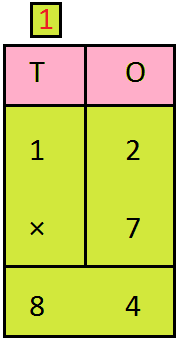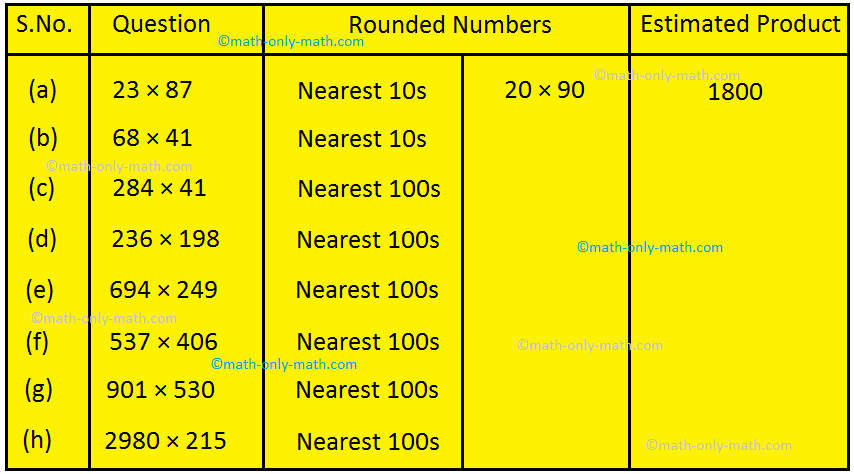Subscribe to our ▶️ YouTube channel 🔴 for the latest videos, updates, and tips.
Estimating Products
Estimating products by rounding numbers to the nearest ten, hundred, thousand etc., we know how to estimate the sum, difference, etc., to the nearest 10, 100, 1000, etc. Now we have to estimate the products.
In order to estimate products, we round the given factors to the required place value. Estimating products help us to check the reasonableness of an answer.
To estimate the product, we first round off the multiplier and the multiplicand to the nearest tens, hundreds, or thousands and then multiply the rounded numbers.
I. Estimate the products of 34 and 86.
34 ⟶ 30 (34 is rounded down to 30)
86 ⟶ 90 (86 rounded up to 90)
|
34 ⟶ 30 86 ⟶ 90 |
34 is rounded down to 30 86 rounded up to 90 |
Calculate mentally 30 × 90 = 2700
The estimated product is 2700.
II. Estimate the products of 331 and 267 by rounding to the nearest hundred.
331 ⟶ 300
267 ⟶ 300
300 × 300 = 90000
The estimated product is 90000.
III. Find the estimated product of 34 and 17 by rounding off to the nearest tens.
Rounding off 34 to nearest tens.
34 is nearer to 30 than 40.
So, 34 is rounded down to 30.
17 is nearer to 20 than 10.
So, 17 is rounded up to 20.
Now 30 × 20 = 600
So, the estimated product of 34 × 17 = 600
IV. Find the estimated product of 148 and 14 by rounding off to the nearest tens.
Rounding off 148 to nearest tens.
148 is nearer to 150 than 140.
So, 148 is rounded up to 150.
14 is nearer to 10 than 20.
So, 14 is rounded down to 10.
Now 150 × 10 = 1500
So, the estimated product of 148 × 14 = 1500
Note:
To estimate the product, round off each factor to its greatest place value and then multiply the rounded off factors.
Consider the following examples on estimating products:
1. Estimate the product: 42 × 57
Solution:
4 2 → 4 0
× 5 7 → × 6 0
2 4 0 0
Thus estimated product = 2400
2. Estimate the product: 47 × 84
Solution:
4 7 × 8 4 47 is rounded up to 50
↓ ↓
5 0 × 8 0 84 is rounded down to 80
= 4 0 0 0
The estimated product = 4000
3. Estimate the product: 74 × 85
Solution:
7 4 × 8 5 74 is rounded up to 80
↓ ↓
7 0 × 9 0 85 is rounded down to 90
= 6 3 0 0
6300 is the estimated product
4. Estimate the product: 358 × 326
Solution:
One number is rounded up and the other is rounded down. Here 358 is
rounded up to the nearest hundred, i.e., 400 while 326 is rounded down
to the nearest hundred, i.e., 300.
3 5 8 × 3 2 6 358 is rounded up to 400
↓ ↓
4 0 0 × 3 0 0 326 is rounded down to 300
= 1 2 0 0 0 0
120000 is the estimated product
5. Estimate the following product by rounding numbers to the nearest;
(i) Hundred
(ii) Ten ‘341 × 267’
Solution:
(i) 3 4 1 × 2 6 7 341 is rounded up to 300
↓ ↓
3 0 0 × 3 0 0 267 is rounded down to 300
= 90,000 & The estimated product is 90,000
(ii) 3 4 1 × 2 6 7 341 is rounded down to 340, the nearest ten
↓ ↓
3 4 0 × 2 7 0 267 is rounded up to 270, the nearest ten
= 91,800 The estimated product is 91,800
6. Estimate the following products:
(i) 747 × 84
(ii) 578 x 35
Solution:
(i) We have 747 × 84
747 → 700
84 → × 80
56,000
Hence, the estimated product is 56,000.
(ii) We have 578 x 35
578 → 600
35 → × 40
24,000
Hence, the estimated product is 24,000.
Word Problems on Estimating Products:
To solve any word problem, we need to read each word carefully and select numbers carefully from the question to solve it.
1. Ron has a crayon box containing 12 colors. He has 7 such boxes. How many crayons does he have in all?
|
Solution: Colors in a crayon box = 15 Total number of boxes = 7 Total number of crayons in. 7 such boxes = 12 × 7 |
TRon has 84 crayons in all.
2. A pair of shoes costs 687. What will be the cost of 8 such pairs of shoes? Give your answer by estimating.
Solution:
Here we have to find the product of 687 and 8, i.e., 687 × 8
687 → 700
8 → × 10
7,000
Hence, the cost of 8 pairs of shoes is about 7,000.
3. The New York Times is published every day. One copy has 14 pages. Everyday 23,750 copies are printed. How many total pages are printed every day? Give your answer by estimating.
Solution:
Here, we have to find the product of 23,750 copies and 14, i.e., 23,750 × 14.
23,750 → 24,000
14 → × 10
2,40,000
Hence 2,40,000 pages are printed everyday.
Worksheet on Estimating Products:
Questions and Answers on Estimation in Multiplication:
1. Find the estimated product for each of the given. First one is done for you.
Answers:
(b) 70 × 40, 28000
(c) 300 × 100, 30000
(d) 200 × 200, 40000
(e) 700 × 200, 140000
(f) 500 × 400, 200000
(g) 900 × 500, 450000
(h) 3000 × 200, 600000
2. Find the estimated product of the following by rounding off the 2 and 3-digit numbers to the nearest tens.
(i) 121 × 17
(ii) 17 × 14
(iii) 93 × 12
(iv) 189 × 15
(v) 164 × 16
(vi) 335 × 13
Answer:
2. (i) 2400
(ii) 200
(iii) 900
(iv) 3800
(v) 3200
(vi) 3400
3. Choose the best estimate and tick the right answer.
I. A shopkeeper has 92 packets of chocolates. If each packet has 37 chocolates, then how many chocolates are there in the shop.
(i) 3600 (ii) 4000
II. A museum has 219 marble jars. Each jar has 178 marbles. What is the total number of marbles in the museum?
(i) 40000 (ii) 50000
III. There are 76 houses in a locality. Each house uses 278 units of electricity each day. How many units of electricity is used each day in the locality?
(i) 24000 (ii) 30000
IV. A hotel has 18 water tanks and each tank has the capacity of 4089 litres of water. What is the total quantity of water that can be stored by the hotel?
(i) 80000 (ii) 16000
Answers:
3. I. (ii)
II. (i)
III. (ii)
IV. (i)
Worksheet on Word Problems on Estimating Products:
4. Solve the given word problems.
(i)There are 157 pages in a book. How many pages are there in 4 such books?
(ii) Mary eat 6 nuts daily. How many nuts does she eat in 120 days?
(iii) Tina bought a pencil box which has 24 pencils in it. If she gets 5 such boxes then how many pencils will she have in all?
(iv) A packet of nuts contains 233 nuts. There are 3 such packets. How many nuts are there in all?
(v) There are 120 students in one class. How many students are there in 8 classes?
(vi) Shelly and her brother filled a basket with 57 fruits. They both together filled 6 such baskets. How many fruits they have in all the baskets?
Answer:
4. (i) 628
(ii) 720
(iii) 120
(iv) 699
(v) 960
(vi) 342
Related Concept
● Addition
● Check for Subtraction and Addition
● Word Problems Involving Addition and Subtraction
● Estimating Sums and Differences
● Multiply a Number by a 2-Digit Number
● Multiplication of a Number by a 3-Digit Number
● Word Problems on Multiplication
● Division of Two-Digit by a One-Digit Numbers
● Division of Four-Digit by a One-Digit Numbers
● Division by 10 and 100 and 1000
● Division by Two-Digit Numbers
From Estimating Products to HOME PAGE
Didn't find what you were looking for? Or want to know more information about Math Only Math. Use this Google Search to find what you need.






New! Comments
Have your say about what you just read! Leave me a comment in the box below. Ask a Question or Answer a Question.